#it makes a cool rainbow gradient :]
Text
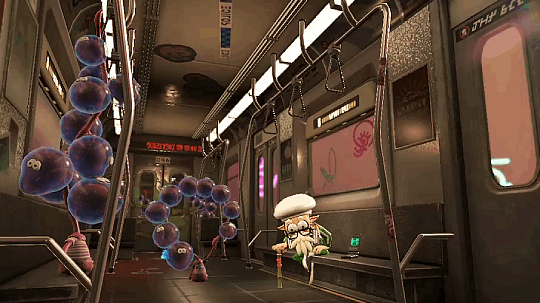

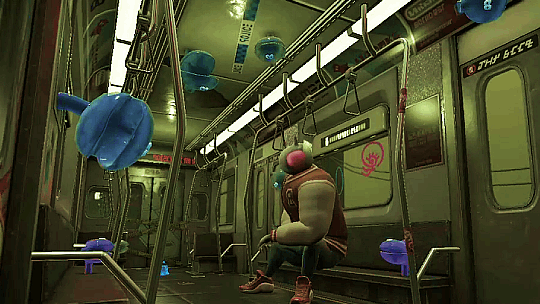
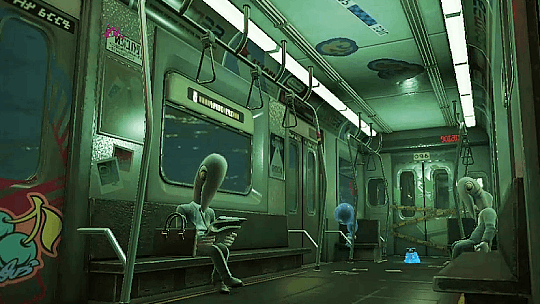
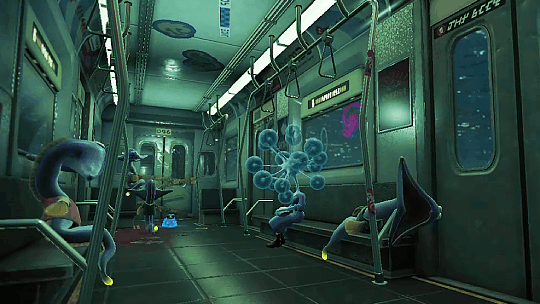
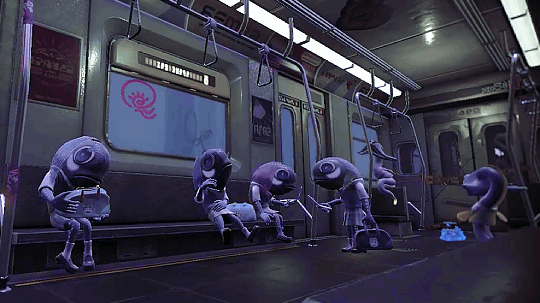
307 notes
·
View notes
Text

ms paint. you know her. u used her age 8 to make loads of rainbow ovals all over the canvas and then scramble it with selection tool. now u will know her true powers with my handyrandy tips under the readmore. some will be pretty basic and others are very special.
this post has 8 cool trix to learn for you. enjoy and i may do another in the future if i remember/learn more stuff
some of it might be common knowledge. but its got some deep cuts. all tips have gifs to show process easily.
🙂 enjoy and i hope this encourages you to fuck around in mspaint more
soundtrack for this post (loop it while you learn for advanced learning experience)
TIP 1) the right click trick
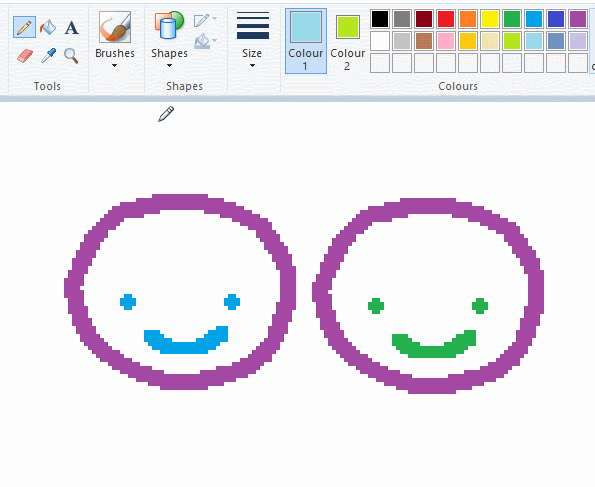

left and right mouse click correspond to col1 and col2 respectively, which u can see in the top bar. this applies to all brushes and the fill tool like above. when using shapes col2 will be the fill colour (if you have solid fill selected). right clicking with shape maker will reverse the colours use on the shape.
TIP 2) right click eraser
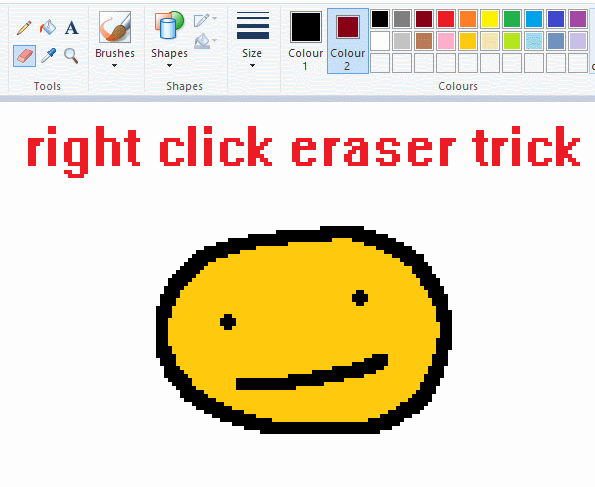
this one is extremely helpful for lineart or add shading. the eraser always uses col2. so your eraser can technically be any colour. but here's where you get powers: right clicking with eraser will only erase onto col1, with col2.
TIP 3) transparent selection change a guy destination

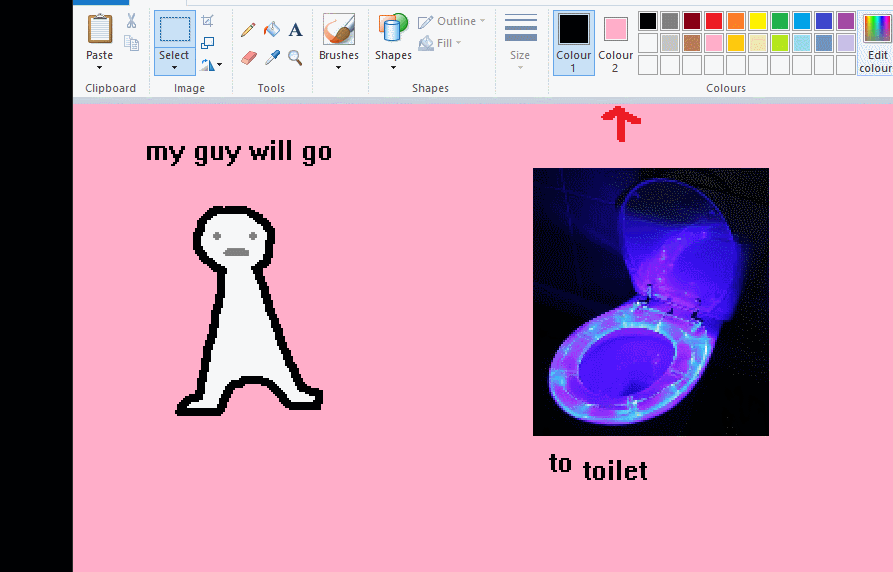
the beloved transparent selection tool works based on what is selected as col2. so long as you have the correct colour as col2 you can make any image transparent and put it on top of anything else. and yes this works with photo bg as you can see.
TIP 4) the gradience

this one is a little more complex. you want to start off with any canvas size, and make as many diagonal coloured bands as you want. (protip: holding down shift makes a perfectly diagonal line with line tool)
then you need to resize the canvas to a width of 1px (make sure you resize by pixels, and do not maintain aspect ratio). then resize again back to its original width (or a different width i cant stop you). you will have your lovely gradience.
TIP 5) superimposter

so. you got a cool gradient and wanna put a guy on it. heres what i do:
i open a 2nd mspaint with same canvas size and draw whatever i want on there. i then pick a completely unrelated colour to my entire piece, and set that as the bg. you could use white, pink, geen, whatever you want as long as it doesnt appear somewhere else in ur drawing. copy the guy.
go back to your gradient tab. ensure that col2 is set as that bg colour you picked (lilac for me). have "transparent selection" enabled. paste your guy in. cue fanfare
TIP 6) advanced superimposter
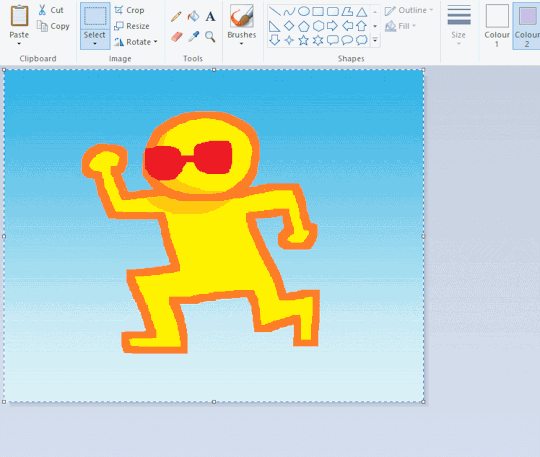
the great thing about this method is u can put multiple gradients in multiple areas of the image. this is where it gets all japanese printmaking type of shit. ukiyo-esque
all you need to do is make another canvas with a new gradient, ensure col2 is set as the colour you want to replace, then paste your original piece onto the new gradient. now my guy has a soft fade. you can do this as much as you want. (you could even make a canvas with a texture or photo and paste your drawing onto there)
TIP 7) "sketch layer"

so as you now know, col2 is what is removed when you click "transparent selection". which means you can also remove any instance of a colour from ur drawing. which means you can have a unique colour for sketch layer and remove it from the drawing later. i admittedly dont do this but it is a great trick to have.
now combine this with lowering your dpi for smoother lines. may seem obvious but it helps. its like a free stabiliser whenever u want.
TIP 8) rainbow art
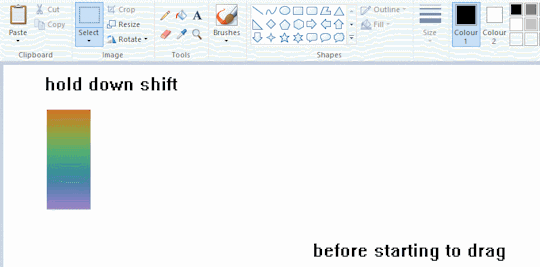

now this is where you can get dizzee rascal "bonkers". check out my small and shitty rainbow trick. you can select anything and hold down shift, then drag with left mouse, to turn that selection into its own brush. i even did it with a guy. and you can of course do this with a photo as well.
🙂well that it for now. hope you liked it thanks for reading now back to your regularly scheduled tgcg programming
2K notes
·
View notes
Text
alright, here it is: ZENO'S COLOR GUIDE 3.0 !

here, i'll have three "chapters" regarding color:
CH1: how i color in illustrations
CH2: color and character design (in zeno's case)
CH3: how zeno makes his colors cooler
CH1: HOW I COLOR IN ILLUSTRATIONS
it must be noted that, as of lately, i heavily use halftones in my art and the way i use them for gradients effects my color choices. of course you don't need to use halftones if you don't want to, as it's just my personal choice, but anything regarding halftones here could (probably) also apply to regular gradients!
when choosing colors in an illustration, i usually have three things in mind: mood, character, and contrast. we'll be using "gloomy bunny naptime" as an example here.
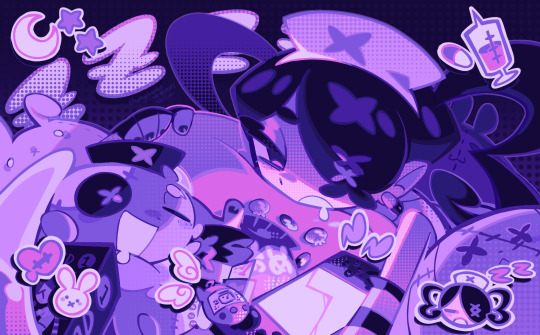
MOOD: what's the vibe of the piece? for example, here in "gloomy bunny naptime", wanted a mellow, sleepy vibe, so purples and pinks seemed like the best choice. these colors also have a dreamy effect due to being common in real-life early mornings/summer nights - basically, i tend to use associative colors in illustrations.
i usually only use a pallete of 3-7 colors, though of course more characters calls for more colors. for multi-character pieces, i would actually make a "rainbow" of colors based on the mood of the piece - essentially, a bank of colors to use for your colorful casts based on the actual rainbow. you can alter this based on the saturation levels you want! hope that makes sense. i'm not the best at this though, so i would heavily recommend looking for guides from artists who are more skilled in that department.
CHARACTER: velvet is the focus of the piece, and as a character her palette is made up of many purples and pinks. of course, it's easier because she and ribbon both have similar designs, but i would still recommend using colors based on/complementary to the focus character's pallete, though this is a rule that can and should be broken if needed. gradients can be used to provide a smooth transition from color-to-color and add depth to the piece, as well as showcase velvet's pallete. when making any gradient, you probably want to have a vibrant middle color. this is difficult to achieve in most art programs, so i'd do it like this:
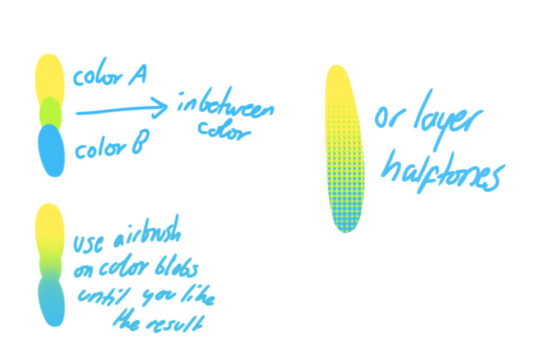
you can use gradients in lots of cool ways to make stuff pop! (i think this collage shows i use too much purple and pink though.)

CONTRAST: the context of the piece also aids the color through contrast. (that's a lot of Cs!)- we see that velvet is just waking up, and the light from her switch is glowing brightly. i wanted to convey something like her switch suddenly turning on in the middle of the night, waking her up - so the console emits "light" in the form of illuminating the contrasting color of pink against the purples. it might seem specific to this piece, but what i'm trying to say is that contrasting colors can lead the eye to the focal point of the piece, that being velvet herself. because a great deal of the rest of the piece is dark, we look at the contrasting switch screen - the brightest thing in frame - and our eyes move around and up to take in the focal point character. at least that's how i wanted it to be ;w; i guess you could convey it as something like this?

CH2: COLOR AND CHARACTER DESIGN (IN ZENO'S CASE)
this is where i start to get annoying, so stand back! when deciding on colors for a cast of characters, there are many factors: time period, variety, personality, and more that i can't think of.
TIME PERIOD: this one is simple. for example, a futuristic time period (such as that in x-calibur) calls for colder colors, such as greens and blues. for characters involved in futuristic professions such as space exploration, this works incredibly well. for modern time periods, less focus can be on colors and more on the shapes of the clothes, but this is not a shapes tutorial! i don't have any ancient times oc stories, but i'd probably use earthy and warm tones.
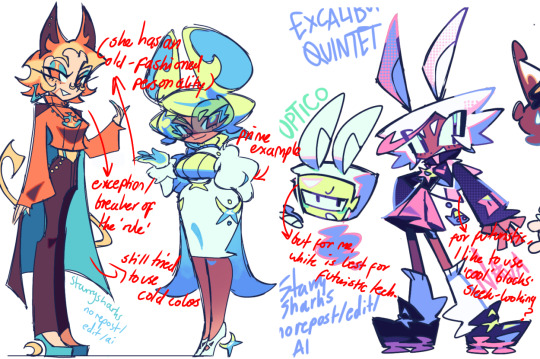
VARIETY: this is also rather simple. i try to be aware of the palletes that i used, and the similarities they might have with other characters. i try to use similar colors for characters who belong to certain organisations or have a uniform, but of course, it's not like catholic school students adhere their entire look to their uniform, so this is a rule that can be broken yet again. art is all about learning things and breaking them, remember that!!!
color can also be used for symbolism. my absolute fav example for this is vivica and octavia - the amount of red in their designs is supposed to represent the amount of freedom/passion/anger/confidence they have or are allowed to express under their different circumstances. as vivica belongs to a strict organisation, she has far less red in her design, showing her emotions are stifled - meanwhile octavia has it as her main complementary color because of her freedom to express her emotions, though those emotions may be destructive because of her circumstances.
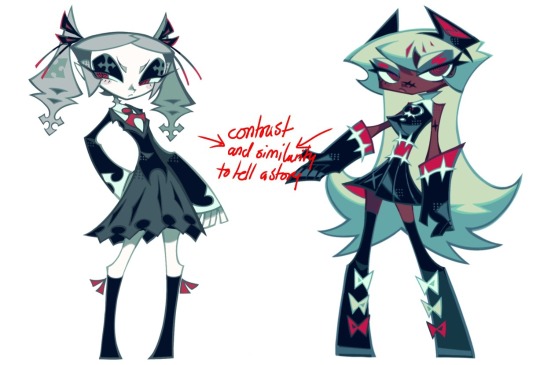
PERSONALITY: what colors are associated with your character's personality? i actually usually refer to magical girl groups to see what's commonly associated with different colors. here's the main trend:
red: hot-headed, passionate, firey
orange/yellow: bright, happy-go-lucky, sunshine personality
green: wise, mellow, kind
blue: serene, graceful, elegant
purple: magical, regal, fancy
pink: usually the main character (though this because magical girl anime tends to be marketed towards young girls), sweet, relatable, determined
of course these are only stereotypes from one genre of anime, and different colors have tons of different meanings. color theory is the best way to learn this! these colors can also express different moods, which ties into ch1. i myself constantly ignore these rules - v-con, a bombastic hyper DJ, is purple (though he does have yellow accents) for example. basically, i just take them as a general rule and try to have them in mind while drawing.
CH3: HOW ZENO MAKES HIS COLORS COOLER
this might be the most important part of this guide. once again, there are a few things to consider here: filters, hue, overlays, and more!
FILTERS: for ibispaint, you can use an adjustment layer on your whole piece to use a filter. i usually only use brightness/contrast here - upping the brightness (or darkening it based on the mood of the piece) and upping the contrast. this helps to better express values and intensify the colors if that's what you want. i often use it in all my pieces to some extent.
hue/saturation/lightness is also helpful in moderation. you can alter the hue - though it usually only helps if you bring it back or forward by just a few points, or the entire pallete will change. saturation is what it sounds like, and slightly over/desaturating the piece can help with atmosphere. lightness is what it sounds like - lightens the colors in the piece. i don't use it at all.
posterize and sharpen mask are some that i've used recently. posterize can add some crazy effects to your art, but i'd probably need to edit it slightly after using it because it can mess with certain colors.

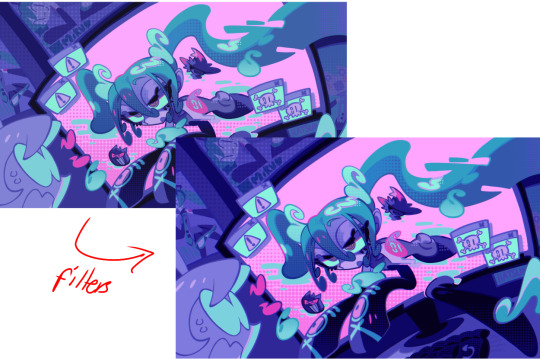
HUE: it's a layer type that can change the overall hue of the piece. i usually use it at a low percentage for atmosphere. kind of like a gradient map but nothing like it? idk
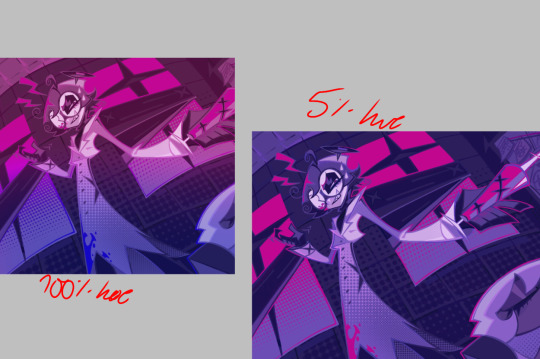
and OVERLAYS: i just use a very saturated blue/purple color over the entire piece at a very low percentage, around 5-10%. it can wash out the piece at too high a percentage.
and that's basically it! sorry it kind of derailed at the end i spent like 2 hours on this and got super tired. goodnight i'm going to sleep please also look at other artists etc etc. bye.
#zeno's art#long post#color tutorial#liar by korn is actually a really catchy song yea the lyrics are weird but its so good tbh#peak drums and bass and guitar and vocals and then the lyrics are hot booty. this is what nu metal's all about people#ask questions if you want#about nu metal or art i dont care
325 notes
·
View notes
Note
wibta for pitting helpless children against each other in battle
this is more of a silly ask than a serious one, but i'll submit it anyway incase its entertaining :]
so I (14nb) do crochet and knitting as a hobby. i dont keep most of the stuff i make, normally i have either made it for someone specific or i jut give it away to friends or family. this is something i like doing! giving gifts makes me happy and i enjoy the act of creating more than the finished product.
recently i made a sort of jacket for a competition. it was a long kinda elf inspired thing, with a rainbow gradient (im shit at describing and i cant add a link to the pattern i used on anon so just pretend it looks really cool ok). i did not end up winning the competition (the judges were genuinely homophobic) but thats ok. so now i just have this jacket that i am never planning to wear. i thought about selling it but it wouldnt sell that well and i dont think im good enough to actually sell my finished pieces yet. i mentioned this when i was with my friends, and both of my friends J (13nb) and L (12f) were like hey i will gladly take that off of your hands :). so i could give it to them. however my younger sister D (10f) has also expressed interest in the jacket.
my mom says i should just give it to my sister. HOWEVER. i think it would be very funny if i made them (lightheartedly) fight for it through a series of competitions for my amusement. it would be adjusted ofc to take the ages into account because D is younger than J and L. i just think this would be a much more silly option than just giving it away this time lmao :} (i also think my friends and sister would be amused by this)
so, tumblr, wibta for having my friends compete against each other more or less for my amusement
What are these acronyms?
#aita#am i the asshole#i was so close to deleting this one as a too-obvious fandom ask before i read the whole thing lmao
126 notes
·
View notes
Text
Investing in T-shirts! The biggest beneficiaries of Gear Adjustments!

For fashion aficionados like myself, Gear Adjustment is the most exciting part of the upcoming Season. Being able to make small changes to the way your gear is worn is something that opens up a ton of customization while requiring less new stuff (though I'm sure it required a lot of work to add). With that said, for the moment, it is looking like they are limiting the feature to caps and t-shirts. I don't personally think caps are changed very much by the ability to flip them, they're all pretty good as they are, after all. But for t-shirts, being able to oversize them is actually really big. Pun unintended.
T-shirts have the tendency to be modeled in a way that makes them cling really tightly to your character's body, and it is has never looked right to me. Looking at the clothing choices I see in my multiplayer games, I get the impression that is the general sentiment, as well. Oversizing shirts solves their central problem, loosening them up and giving you a less constrained silhouette. In this post, I wanna highlight what I think are the biggest winners of this change are. Shirts I think you should pay attention to once the patch hits.
That said, I should highlight that since we don't have the patch yet I am only assuming these will be Adjustable. We cannot know for sure until the we get the update.
I've picked out ten T-shirts I think are the standouts, split into a couple of different categories, starting with the ones I think you all expected to see here:
Annaki Accessories!
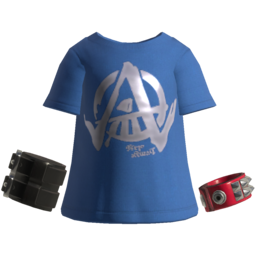
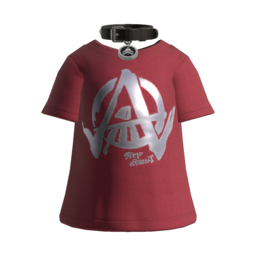
I have to imagine that the Annaki Bracelet Tee and Annaki Choker Tee were some of the first shirts that came to mind when you think of noteworthy T-shirts in this game. They've got nice, dusty colors, the big Annaki A in slick silver, and of course their signature accessories. Oversizing these I think will amplify their punk aesthetic even more, because there's nothing punk about tight-fitting clothing.
Unless it's leather.
And leather these are not.
High-fives for Tie-Dyes!


Tie-Dyes are really fun with their bright, trippy patterns, so it's no surprise that the Takoroka Rainbow Tie Dye and the Takoroka Galactic Tie Dye are some of the better T-shirts in the game. We did see the Rainbow Tie Dye get Adjusted in the reveal trailer, and is it just me or does that just seem right for these kinds of shirts? Something about them screams "wear me at one size larger."
Ride the Wave!
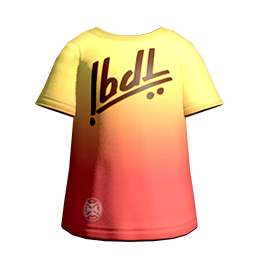
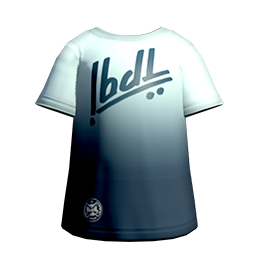

Next up, we've got the Firewave Tee, Icewave Tee, and the Vaporwave Tee. There is also a Duskwave Tee, but I am personally not a big fan of the shade of orange they use for the bottom half of that shirt. That said, I think the gradient on these shirts them really make them stand out from the rest, and their color palettes are just very nice and evocative.
Assorted Graphic Tees!



These three don't have a common throughline aside from all being graphic tees, but I think they all have something to recommend them by. The Eelzebub Tee has a really gnarly, radiation-green design that is just really cool, giving an outfit something really eye-catching while still staying nice and simple.
The Green Tee is interesting because its big bold graphic lettering actually extend across the side and even a bit onto the back of your character, which gives it a really unique look I don't think any other clothes can replicate.
Finally, I just think the Mint Tee looks nice. Its color is pretty unique amongst shirts, and the white print design is decorative without being overbearing.
And these were my picks for the T-shirts to keep in mind come Drizzle Season 2023. Were there any others you feel I missed? If so, please tell me in the notes!
105 notes
·
View notes
Note
Your zoo sketchbook pages were amazing!! You got so many drawings done as well, what’s your progress when doing art at a zoo? Or do you have any tips for those who want to do the same? :0
Thank you!!
When doing gesture drawings, you have to go FAST, especially with wiggly animals. All my drawings tend to be around 1-2 minutes or less (average 30-45 seconds? I’ve never really timed myself). With that, here’s what I try to keep in mind:
Part of it is choosing your subject. I like ungulates because hoofed animals are REALLY FUCKING WEIRD and have so many shapes in them. They tend to stay still long enough to get good poses too.
So take this Okapi.

The things I try to focus on are capturing the overall silhouette, while also maintaining clarity. You can do this by not only paying close attention to the outer contours, but also the negative spaces in between. Getting the contours right will help you maintain the likeness of the animal, and checking the negative spaces will help to keep everything in proportion.

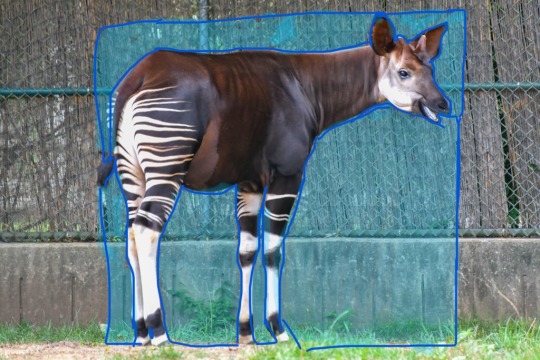
on top of that, mentally break apart your subject into layers and focus on planes. Pay attention to overlapping shapes (a very subtle but important thing for making your drawings look three dimensional rather than flat)

I like to draw with pen, but there’s really no rule. Sometimes I use a rainbow pencil. If you have multiple shades, use a lighter value (or even just use some open hatching) if you want to indicate and cool markings the animal has. For example:

In this sleepy tapir drawing, I used hatching to show the subtle gradient of the dark part of its nose. I like to keep my lines directional to help indicate the volume of the form, too!
And really, these are all techniques I do with all kinds of life drawing! Drawing at the zoo is one of my favorite things ever because of the challenge of going fast & the huge variety of things to draw!!
550 notes
·
View notes
Text
A stream has started, but it's not in a virtual space. It's in a semi-empty warehouse. In frame are a set of large screens, a variety of tech setup, speakers, and some boxes/containers marked with the Genius Built logo.
The screens activate, a loading animation plays before going to a rainbow gradient background and the base models for all Four turtles walk across with one stopping every few feet in order of Raph, Donnie, Leo and Mikey.
Donnie: Hello members of the Bale, we're testing some new toys I got together for future events!
Leo: Gotta admit this looks pretty cool Dee.
Mikey: We're still going to figure out costumes for going in person right? It would be boring to just use screens.
Raphs model sits down and just smiles at his brothers. He's decided to just watch them have fun with this. He also doesn't have a mic on him for this stream.
Donnie: Of course, or else they would go to waste.
Leo and Mikey look confused, until in the warehouse Shelldon zooms past, and River follows after. They come back into frame a second later. Raph looks amazed.
Shelldon: Hey Dudes! Hope to see you IRL soon!
River: I got an upgrade!! And can't wait to join in on events!
Leo & Mikey: Awesome!
Leo: Wait, when did you last sleep?
Donnie: I got a solid 5 hours.
Mikey: At once or over the course of the last few days?
Donnie looks nervous, but composes himself.
Donnie: We'll worry about my sleep schedule later, I want to show off some of the overlays I had Mikey make for this setup!
Raph looks exasperated, and about ready to drag Donnie to bed, but he's decided this is a Leo's in charge moment.
They mess around with the screens, lights, and other stuff, including Shelldon and River being able to somewhat manipulate what's on the screen, like pushing over one of the turtle models, or objects that are spawned in.
Chat isn't so much ignored as much as the prompter was apparently not able to handle the spam of chat, messages, and notifications.
Masterpost
#VTurtles!#vtuber au#vturtles!#rottmnt donatello#rottmnt donnie#rottmnt leonardo#rottmnt leo#rottmnt michelangelo#rottmnt mikey#rottmnt raphael#rottmnt raph#rottmnt au#rise donatello#rise leonardo#rise michelangelo#rise raphael#rise donnie#rise leo#rise mikey#rise raph#rottmnt#rise of the teenage mutant ninja turtles#rise of the tmnt#rise tmnt#tmnt rise#tmnt 2018#teenage mutant ninja turtles#tmnt#tmnt fanfiction
32 notes
·
View notes
Text
A harbringer of death, a witch with something wicked inside, and a kidnapped watcher — the perfect combination of siblings, yeah?
Cursed Trio / Cursed Siblings HCs!
- Grian oldest, pearl middle, & Jimmy youngest ?
-> Grian being the older sibling whose supposed to be responsible but is just so not is too funny to pass up
- they don’t have parents, they just spawned one day and then grian created EVO
- Grian is the feral older brother who didn’t know what he was doing so thats why pearl is… like that
-> he got a bit better when jimmy spawned
- they all have pronouns ://
-> Grian = he/they
-> Pearl = She/They
-> Jimmy = ftm He/Him
- the capitalization is on purpose, grian does not care enough about gender to capitalize his pronouns
- WINGS! wings wings wings wings wings win
n e ways: wing headcanons

Grian: Obviously, the rainbow parrot bird wings. we all know where the wings originate from but i’d also like to imagine that, like a male bird, grian is colorful because they were the oldest, the “protector” of his siblings, so he was the brightest and most colorful to distract predators (mobs in this case) from their younger siblings

Pearl: now i haven’t seen many Pearl wing headcanons but i’d like to think that Pearl’s wings are bigass raven wings that she can use to make herself look more intimidating. Also, raven symbolism = every time you see a raven, death is approaching. They would also be easy to conceal under a dark jacket, like the black one they have.

Jimmy: the famed canary wings! canary, obviously referring to “canary in the coal mine.” the yellow to white gradient also looks almost ghostly in sunlight. jimmy is a naturally good singer and very friendly, like canaries often are, but keeping them in cages means there’s a ghost around. too bad he’s usually the ghost that’s around :(
- also i think it’s incredibly funny that, though parrots can grow to be 40 inches, ravens behind at 24-27 inches, and canaries only averaging around 3-5 inches, jimmy is the tallest sibling with pearl being a close second
- jimmy was obsessed with making random animals nests when he was younger:
-> finds a chicken
-> makes it a nest
-> cries when the chicken walks away
- whenever they’re on the same server, grian will just pick jimmy up (cuz tho he is short, their wings are very strong & fcking massive) and throw him like when he was teaching him to fly
- he has attempted this with pearl Once, and never again
- jimmy is the only one who preens his wings on the “regular,” but even then he only preens them like every three months when they are absolutely awful
-> the other two are TERRIBLE about preening
-> they get that hermitcraft hyperfixation that all the hermits get when starting a new build or redstone machine
- all of them are fairly light weight, though all looking like body-builders cuz hollow bird bones
- pearl is so done with her dumb older & younger brothers, at all times
- they will go days without seeing grian, or even weeks without seeing jimmy cuz of the server differences but the moment she sees them she just deflates
- exhausted
- she is very protective tho :) she joined empires to keep jimmy in check and then joined hermitcraft cuz they knew grian needed someone to keep HIM in check
- this was only a few days apart (empires - June 12, 21 / hermitcraft - June 19, 21)
- pearl joined to keep them in check, she failed, they both caused chaos and she joined in
- Pearl = goddess, Grian = watcher, Jimmy = listener
-> they use their abilities to cause mayhem and wreak havoc
- when it was “revealed” that lizzie and jimmy were seablings pearl and grian were jealous that jimmy got to be siblings with somebody cool AGAIN but they were stuck with him
- jimmy was offended they didn’t think he was cool
- both times jimmy has acquired a husband/partner, grian and pearl both had “the talk” with them
-unfortunately, they are simply too goofy to be taken seriously so both scott and tango were unconcerned until pearl’s eyes starting glowing white and grian’s wings were covered in massive purple glowing eyes
- both scott & tango asked jimmy if he could do cool stuff like that after they calmed down
-> he gave a wistful little sigh and said, “no, all i can do is hear down to atoms. not so impressing.”
- much confusion, those days
- feathers:
- jimmy gives feathers out like candy; to his family, his friends, his loves, etc.
- grian only ever gives his feathers out to very close ppl; their siblings and scar & mumbo
- pearl never gives her feathers out; they have a deep seeded fear of her feathers not being pretty enough in comparison to their brother’s bright colorful ones
-> the only time she’s given them is to her brothers when they were like 9
- they love each other !!! oh em gee
#grian hermitcraft#grian#pearl#pearl hermitcraft#pearlescentmoon#jimmy solidarity#hermitcraft#headcanons#hermitcraft headcanons#cursed trio#cursed siblings#bird grian#canary jimmy#canary in the coal mine#trafficshipping#solidaritek#flower husbands#bird pearlescentmoon#bird pearl#mcyt#double life#double life smp#empires jimmy#hermitshipping#mumscarian
424 notes
·
View notes
Text
their beaks not yet turned red by @chaparral-crown
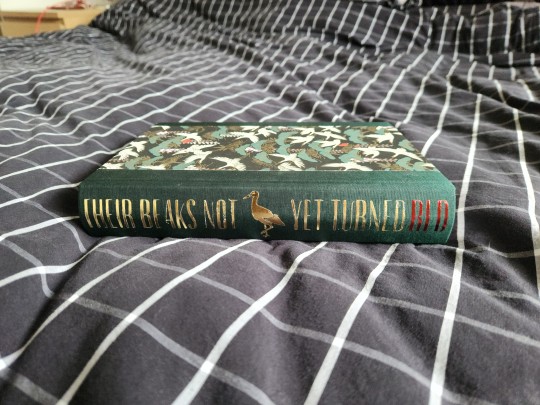
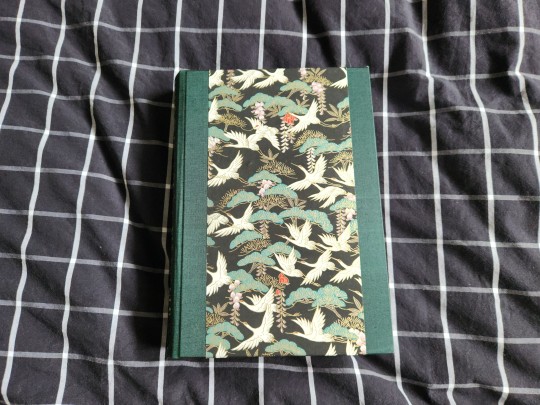
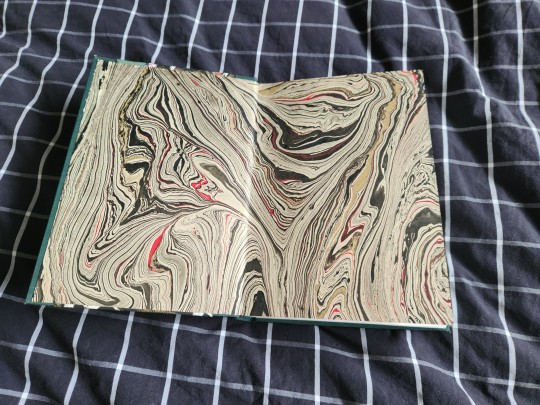
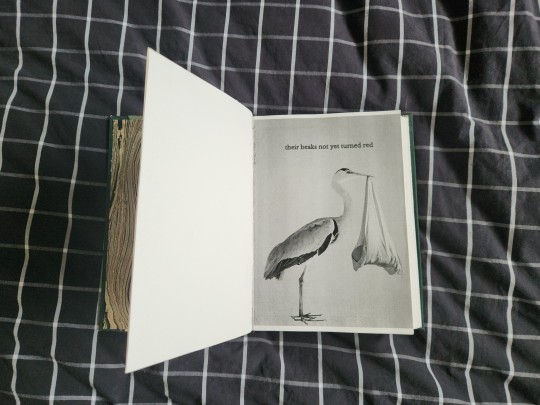


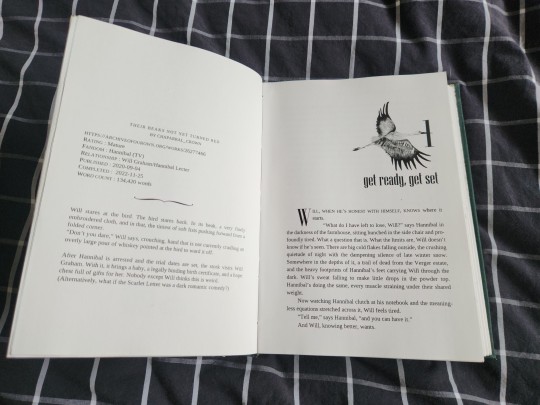

Details under the cut!
So this bind has been waiting for a while - i started prepping this in December 2022 but fixated on the idea of a cut-out. Made a mistake with the board-buying so I decided to go move on without it. i'll probably be trying out quarto books after Binderary is over. have a couple of shorter fics on my list--- if i figure out quarto, it means i can bind more things!
Statistics
134,420 words || 411 pages
Body text: Liberation Serif, 11 point
Accents: Voga, Niagara Solid font
So - the fic is delightful and as you can probably tell from the design - has something to do with storks and babies. I leant into that heavily for the design. I also wanted to use the same bookcloth as what i used for each according to its kind, hence the green - with a green and black chiyogami paper. (I had also misread that cranes and storks come from the same family of birds, but okay, they only look similar, i have failed as a bird cult adjacent)
the endbands are green and blue silk - this was one of first few attempts in december so they are not as nice as my current attempts, but it's okay.
Endpapers are marble papers from De Milo design studio and letter press. I actually accidentally bought the really thick cardstock version and now i think i could possibly get away with using the text weight, but i really liked its colour and thought the splashes of red were a great counterpoint and made me think of the chiyogami paper with hints of red.
Anyway - i also sorted my book shelf into a colour gradient - and it looks pretty cool (but also highlights that i don't have enough colours to make the colours of the rainbow and i'll be binding some blue, indigo and violet books immediately).
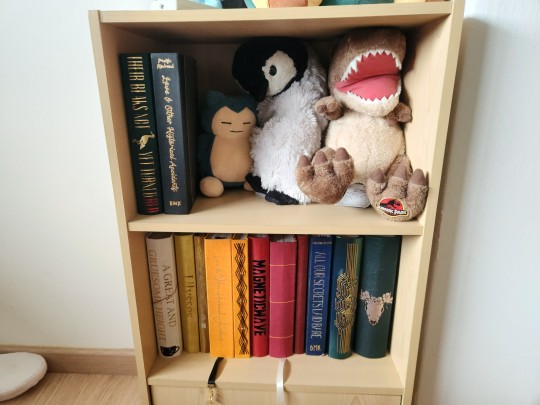
Anyway sadly my 1 week of leave is over (hence the 4 books in a week), my hope is that when i can next bind - i can work on manda's books as well as my mildly overdue author copy for A Light in the Fog, which has since been printed and trimmed and rounded but is caseless and taunting me and i can fulfill my PORPLE FIX.
#bookbinding#fanbinding#my books#renegade bindery#binderary2023#ficbinding#hannibal#hannigram#will graham#chaparral_crown#their beaks not yet turned red
160 notes
·
View notes
Photo
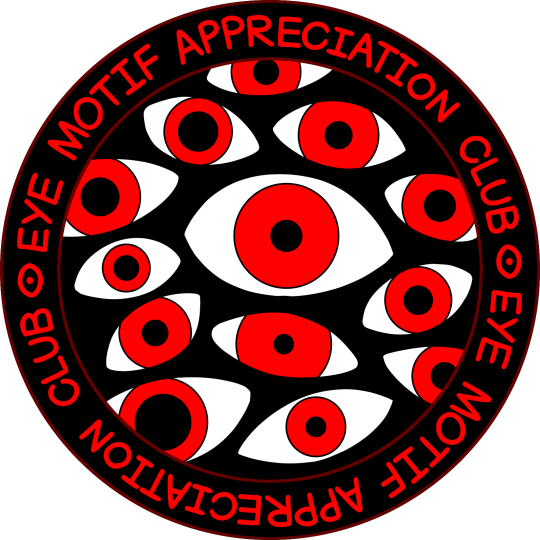
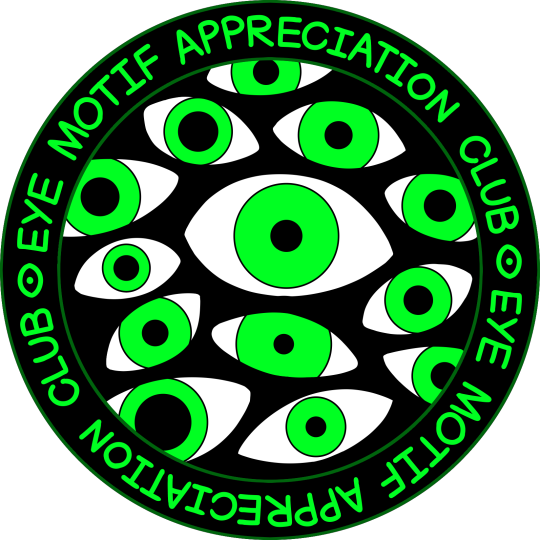
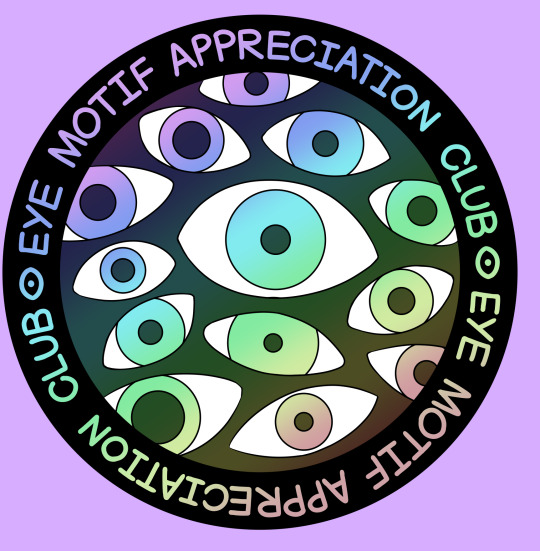
[image description: 3 images of the same design in different colours. its a circle where the inside is filled with simple drawn eyes with a black background. the outside border is black with the words “eye motif appreciation club” written twice with a small styalised eye logo between them. the text wraps around inside the border in a circle.
the first image has the text and iris in red, the second in green. the 3rd is slightly different, missing the border lines of the border, and the iris and text are in a light rainbow gradient, and the pupils and background has a dark rainbow gradient. end id]
saw a deal on stickers and this was the only design i managed to do but its fine because i realised the deal i saw was still more expensive than another site so im using the cheaper manufacturer. still good quality anyway.
i’m getting them in holographic because i think it’d look cool. ive already got sample so im going to see how they turn out. anyway i was going to go with just the silvery iridecent and the red but decided to see how green looks. the last image is my attempt at making a mockup of a holographic version
anyway my reason for this design is that im a sucker for a cool eye motif!! fucking love them. i have a jacket thats just full of eyes, mostly patches, but its kind of hard to get eye patches because when you search that you get eye patches (the face wearing kind) and not eye patches (iron/sew on patches that are of eyes)
anyway i have the red and green versions on my redbubble, i’ll rb with a link to that
#eyes#eye motif#eye aesthetic#tma#the magnus archieves#not really but i also happen to like tma and tma fans also happen to like cool eye stuff#so enjoy
211 notes
·
View notes
Note
HI!! okay sorry to bother u but how do u get cool funky colors on tumblr like in ur navigation it’s all pink and pretty (◞‸◟) maybe i’m just dumb idk
UR AWESOME MWUAH
hi anon!! of course!! the key to this is to get a website that makes an html code for you to paste into tumblr. there are a lot of these but i use this one:
once you open it you'll see this

the top box is where you can add whatever text you want:

then you can pick the gradient/setting:
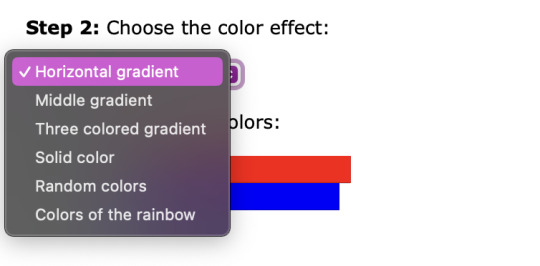
for fics i use the horizontal and pick 2 colours, but for my theme i used the solid colour and picked 3 different shades of pink to alternate
so here's an example of what i picked out, the text, gradient, and colours

it'll preview what it will look like under step 5 ^^
the code you want to copy is the 'html code for this text'. you'll want to copy all of it (it can get long) and then go to tumblr

we'll make a new post and you'll want to click on the gear icon at the top right corner
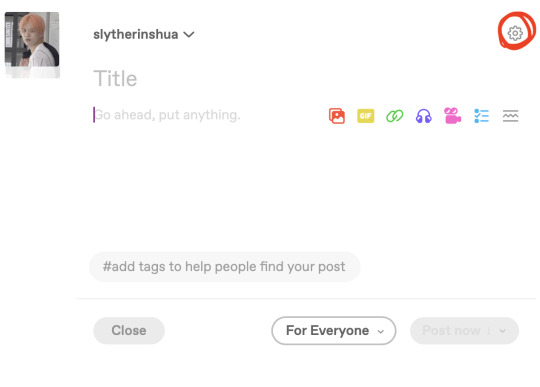
it'll pop up a menu and you should go down to 'text editor' and select the html option

once you select that option, you'll get a new formatting menu on the post. we have the html menu and the preview now
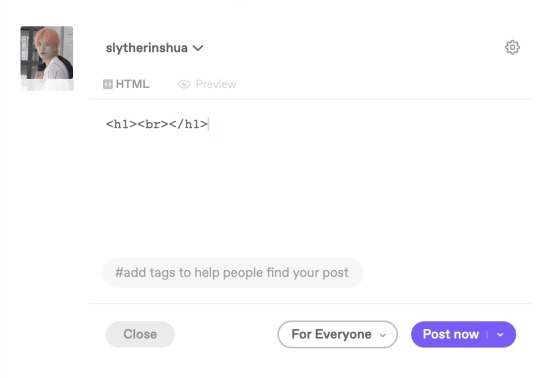
so now we can paste the html code that we just copied
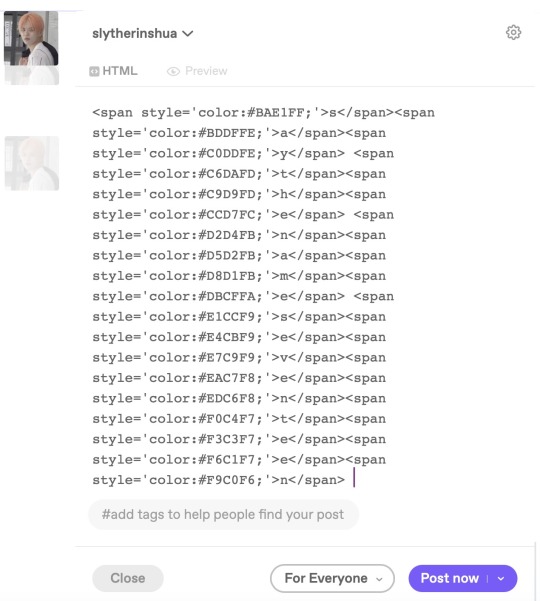
and now once you go to the preview menu it'll look like this!!
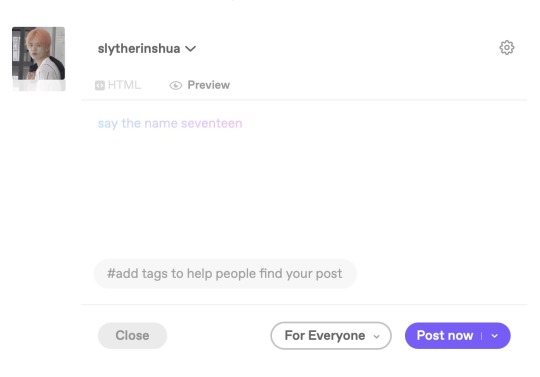
you can format and adjust it like normal text now using the preview menu and get smth like this :D
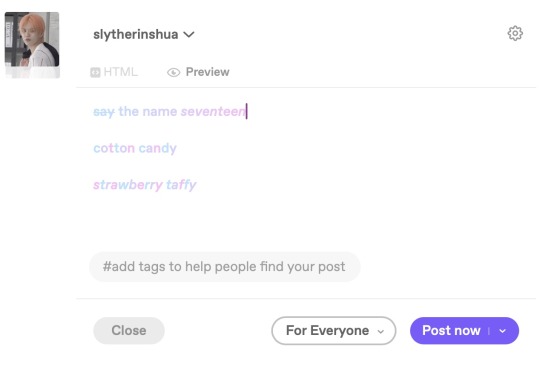
i hope this made sense but if you have any more questions then i'm happy to help!!
28 notes
·
View notes
Text
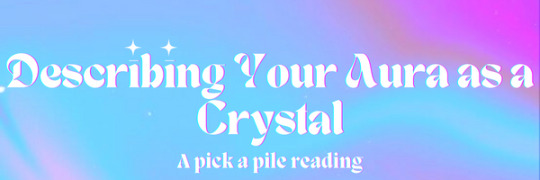
Paid Readings | Patreon | GofundMe
I've added a new service to my shop, where it'll be like this reading but more in depth, and I will also channel how your aura affects others and any other additional messages that I pick up.



*:・゚✧*:・゚ Pile One *:・゚✧*:・゚
Your Aura is Bumblebee Jasper.
It primarily consists of warm colors like orange, yellow, and red, with thin strips of cool colors like green, purple, or blue. The gradient of these colors melt on to each other like the sun's reflection on an ocean when it sets. I feel like your aura is something that inverts. A lot of you could have an ambivert personality, or phases in your life that shift from endearing life and having the utmost faith for all of the positive that it could bring to loathing life and expecting only the mundane and nothing but the worst. Maybe some of you were agnostic/atheist at some point of your life but had a dark night of the soul that brought you to a spiritual awakening, but the lovely part about your aura, is that it resembles how much you guys are able to exchange both light and the dark side of energy to find out the bare truth of a situation (maybe even about your purpose in life itself) and how to brew ideas that will bring solutions.
*:・゚✧*:・゚ Pile Two *:・゚✧*:・゚
Your Aura is Red Tiger's Eye.
Your Aura starts off with fuchsia before it grows deeper into a pigment that's more maroon that ends with a thin layer of black. Sex appeal comes naturally to you, and passion could be something that exhilirates you, even if you're lunging for something that could potentially leave you in a trench. You guys could be pretty impulsive when it comes to your relationships or attract people that have a deep infatuation for the idea that they have of you. Intensity is what makes you thrive emotionally and what you look for in a romantic interest, and you can't stand anything that lacks meaning. However, as much as you search for depth in both people and concepts, your impulsiveness may make you near-sighted. Going with what you can see and feel first-hand, instead of rationally observing a person or situation for what it actually is. Confidence is also what your aura speaks of. Its potency talks about relying on your raw inner power. If you don't already, then there's a need to recognize that you don't need to try "hard" for anything, and the things that you do effortlessly is what draws people in. You don't need to be toned down or exaggerated.
*:・゚✧*:・゚Pile Three *:・゚✧*:・゚
Your Aura is Prehnite.
Your Aura is has multiple shades of green that range from mint to a shade that likens to pandan. I keep thinking of different green plants and herbs, so right off the bat, I'm getting that you're able to soothe yourself, like eucalyptus. Maybe you guys meditate a lot or had to learn how to regulate your breathing and relaxing your mind. There's something very Saturn like about your aura. Possibly, you guys have experienced a lot of loss and challenges at a young age, and growing up has just been about building yourself back up again or learning how to heal yourself so that you can heal others. You guys could be fluent speakers or there is something about your voice that's placid but at the same time inviting. Your Aura is soft on the eyes, but at the same time strong? It shows strength and also reliability, like it shows people that you're someone that they can lean on and trust, during troubling times.
*:・゚✧*:・゚ Pile Four *:・゚✧*:・゚
Your Aura is Rainbow Obsidian.
Your Aura is predominantly dark grey and black with trickles of purple and green. It sounds murky, but your aura is actually pretty luminous. I sense a lot of rebirths that has happened for people in this pile, but also ethereal miracles in situations that felt like a dead end. Sight is being emphasized here. You could be described as someone who's esoteric. You guys could be well in tune with spirituality, the occult, or religion because of what you've personally experienced that most will not understand, which usually relates to what cannot be seen or what would be looked at as impossible. This is different from clairvoyance, but more like claircognizance. You guys could be on a path where you release knowing what the future holds for you, even when there's chaos around you. It's like you have a gift of getting answers without necessarily seeking them, by just releasing control. Your Aura makes you a motivating force for other people during dark times, based off of what you've endured and how you still maintain mellow optimism for how your life can still turn around for the better even when things feel like an endless purgatory.
#divination#intuitive#psychic#pick a card#oracle#spirituality#tarot#pac#pick a pile#tarot readings#tarot reader#tarotblr
373 notes
·
View notes
Text



randy gradient tests & findings
hey guys ive been experimencing with new gradient techniques to get phun-nu-FX (fun new effects) and i have some pretty cooll stuff to share
i explained how 2 make a gradient >>>here in this post<<< so employ that tek here
spray can haze

this is something that looks fuckt when you set it up but really delivers. using spraycan to "blur out" the gradient gives it this layered, grainy FX. you can put lines of other colurs in with the spray brush to add interesting tints to the haze. i used this on my recent snow drawin for the sky with white+light blue.
crayon sunset
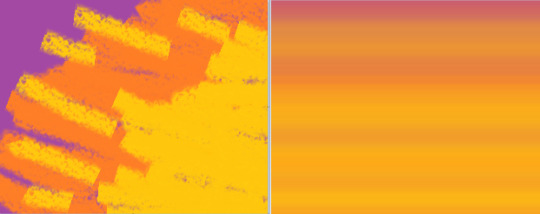
usin the crayon for this gives a softer effect w less scanline-y a texture. its very soft and pretty. i personally prefer this over using the paintbrushes for gradience because i literally just dont like mspaints "paintbrushes". do what you want tho
i realy encourage messin around with this and seeing what you can make
width makes columns

so the standard 4 the gradient method is to reduce the width to 1px then resize to orignal. well, its also pretty fun to mess with diff widths cus you can get some interesting abstract shit.
this is what happens if you set the width as 5px instead of 1px. you get 5 equal-size columns that kinda deconstruct ur image. its very interesting
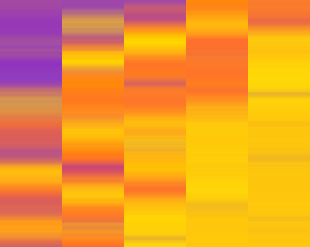
here is the last gradient design if i also did 5px width to it. you can get a bunch of gradients from one gradient basically
i thought this was worth sharing because well its fun to look at & think about
rainbow art +
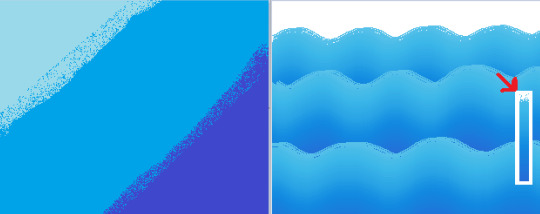
rainbow art is cool as fuck. rainbow art is what icall it when you make a fun gradient and shift+drag it to use it as its own brush
you can make really cool+nasty backgrounds using rainbow art over itself like this kinda ocean-y pattern. i included what my "rainbow art brush" looked like to make it
well i hope this helps you to think about fun ways to use mspaint to its full potention. its a very fun thing to do. take care
78 notes
·
View notes
Text
What's in my Magician Maker picrew?
I will try to answer this to the best of my abilities!
Skin colours

There are 16 different skin colours! Regular human colours and some more alien-like! Yellow and Green are dark because they're meant for specific fandom characters. Grey is here for all the homestuck trolls
2. Ears
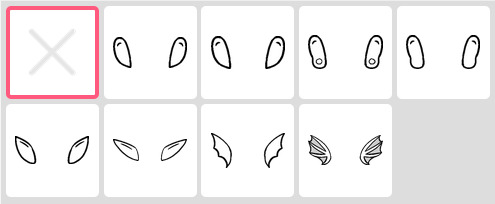
Normal ears, elf ears, mermaid fins! And earrings that fit each!
3. Vitiligo, freckles, scars, etc

Vitiligo comes in 6 different faces pattern, with the possibility of extending it to the whole body. There are three density of freckles in 6 colours to accomodate the different skin colours. There are also cheek scales, beauty marks, simple birthmarks, acne, and two attempts at portraying rashes/eczema in my style.
All of those are in one category so can't be combined
Wrinkles and scars are in different categories tho! Scars include: various facial gashes, tiny cuts, cleft lip, lichtenberg figures, burn scars, punch cheeks/black eye, frankenstein-like sutures, fantasy cracky of the skin! Each of the option actually hide a second scar in the colors
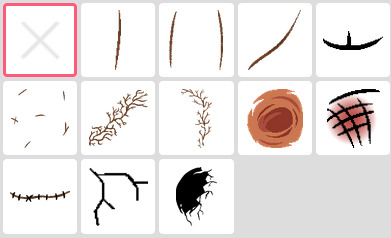
4. Facial features
Noses and mouths are pretty classic and their preview showcases what you'll get rather accurately. Eyebrows change in thickness/shape/colour when going through the colour option.
Colour options on the eye shape will change the mascara, or make it wink. The 3+ eyes offer a different set instead of winking. The sclera can be changed to different colours. The iris section helps show the various eye shapes.

5. Eyewears
Once again, some digging through colour options is necessary to find all of the eyewears (24 total with colour variations + 8 eyepatches)

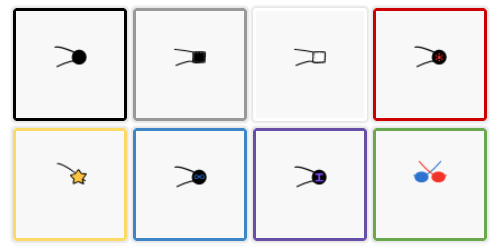
6. Hijab
There are 7 different head covering with 6 unique colours for each! Some have very cool patterns if I may say so

7. Hair
There are different facial hair available in various colours, including some funny moustaches
Hair is very customisable, with straight, wavy, curly and kinky hair, all available in 18 colours, including a rainbow and a bicolour (blonde/black) options. Some hair can also have a gradient dye of black, red or blue. Examples:

8. Prosthetics
In the body section, it's possible to not have any arms, but there's also the robot arm option in the sleeve section. There's also a hook hand somewhere in the items. This is probably the most lacking section of the picrew ^^; If you have suggestions on things to add, send an ask.

9. Hand gestures

All of those come with gloves (short, long and fingerless) options, black nailpolish, and rings if possible to show. Also LOVE HATE knuckles tattoos. The 6th and 9th gestures are made to hold something: the main goal is to hold a wand because this is called "magician maker" but you can hold flags, flowers, or even a bird


10. Wands
A magician needs a wand! This is where the "gloomverse" aspect of this picrew comes in: I'm sure not everyone would call those things "wands", but in the lore of the comic, they can be! Canonical gloomverse wands examples:

But you can do so much more, if you explore a little ;)

11. Hats!
As important as wands, the hat of a magician! They can look like anything and have a lot of decoration on them. Hats can be created by choosing the brim and top's shapes, or you can choose already made ones:



Decorations are sorted by types, so I encourage exploration! They can make for fun add-on to a character, like the ears and horns:

12. Clothings
Each clothes come in 5 different "body types" with various cup sizes. That is the best I could come up with without quadrupling my workload.

There are a lot of way to customise the clothes. There's the clothes under, over, the collar, the sleeves, pride buttons/pins, logos, etc. Mostly homestuck references. Pride flags that aren't on the pins are in the background options*. Pronoun pins include: He/Him ; She/Her ; He/They ; She/They ; They/Them ; Ze/Hir ; Ze/Zir ; Fae/Faer ; It/Its


*(flags have been sorted in sexual orientation / gender / aspec at first, but due to people requesting more flags, it's not as clear cut. There are also blue version of pride flags due to fandom stuff, they're not official at all)
There's a lot more that could be said, but that's more than enough already!
#picrew#art#character maker#gloomverse#homestuck#magician maker#dollmaker#my picrew#long post#I never did a full presentation of my picrew so!! here!
11 notes
·
View notes
Text
Transcript Episode 83: How kids learn Q’anjob’al and other Mayan languages - Interview with Pedro Mateo Pedro
This is a transcript for Lingthusiasm episode ‘How kids learn Q’anjob’al and other Mayan languages - Interview with Pedro Mateo Pedro’. It’s been lightly edited for readability. Listen to the episode here or wherever you get your podcasts. Links to studies mentioned and further reading can be found on the episode show notes page.
[Music]
Gretchen: Welcome to Lingthusiasm, a podcast that’s enthusiastic about linguistics! I’m Gretchen McCulloch. I’m here with Dr. Pedro Mateo Pedro who’s an Assistant Professor at the University of Toronto, Canada, a native speaker of Q’anjob’al, and a learner of Kaqchikel. Today, we’re getting enthusiastic about kids acquiring Indigenous languages.
But first, some announcements. We love looking up whether two words that look kind of similar are actually historically related, but the history of a word doesn’t have to define how it’s used today. To celebrate how we can grow up to be more than we ever expected, we have new merch that says, “Etymology isn’t Destiny.” Our artist, Lucy Maddox, has made “Etymology isn’t Destiny” into a swoopy, cursive design with a fun little destiny star on the dot of the eye, available in black, white, and my personal favourite, rainbow gradient. This design is available on lots of different colours and styles of shirts. We’ve got hoodies, tank tops, t-shirts in classic fit, relaxed fit, curved fit – plus mugs, notebooks, stickers, water bottles, zipper pouches. You know, if it’s on Redbubble, we might’ve put “Etymology isn’t Destiny” on it.
We also have tons of other lingthusiastic merch available in our merch store at lingthusiasm.com/merch. I have to say, it makes a great gift to give to a linguistics enthusiast in your life or to request as a gift if you are that linguistics enthusiast.
We also wanna give a special shoutout to our aesthetic redesign of the International Phonetic Alphabet. Last year, we reorganised the classic IPA chart to have colours and have little cute circles and not just be boring grey lines of boxes and to even more elegantly represent the principle that the location of the symbols and rows and columns represents the place and degree of constriction in the mouth. I think it looks really cool. It’s also a fun little puzzle to sit there and figure out which of the specific circles around different things stands for what. We’ve now made this aesthetic IPA chart redesign available on lots more merch options, including several different sizes of posters from small ones you can put on a corkboard to large ones you can put up in your hallway. They look really, really good, especially if you have some sort of office-y space that needs to be decorated. Plus, it’s on tote bags and notebooks and t-shirts. If you want everyone you meet to know that you’re a giant linguistics nerd, you can take them to conferences and use them to start nerdy conversations with people.
If you like the idea of linguistics merch but none of ours so far is quite hitting your aesthetic, or if there’s an item that Redbubble sells that you think one of our existing designs would look good on, we’ve added quite a few merch items in response to people’s requests over the years, so we’d love to know where the gaps still are and keep an eye on lingthusiasm.com/merch.
Our most recent bonus episode was a behind-the-scenes interview with Sarah Dopierala, who you may recognise as a name from the end credits, about what it’s like doing transcripts from a linguistics perspective and her life generally as a linguistics grad student. You can go to patreon.com/lingthusiasm to get access to all of the many bonus episodes and to help Lingthusiasm keep running.
[Music]
Gretchen: Hello, Pedro, welcome to the show!
Pedro: Hello. Thank you so much for this invitation. I really appreciate it.
Gretchen: We’re really excited to have you. Let’s start with the question that we ask all of our guests, “How did you get interested in linguistics?”
Pedro: That’s an interesting question. I think there’re two main things. One is that I had the opportunity to attend a boarding school where there were many Mayan languages and, in addition to that, there was a class on grammar of Mayan languages, and I think that’s one of the things that motivated me to be curious about that language. Then after becoming an elementary school teacher, I was also interested about knowing more about how these languages work. For example, how language works in this case – well, in the case of Guatemala, for example, people think – I am assuming that that was in the past, but there’s, I think, some people who still think that Indigenous languages don’t have a grammar from there as well. Is it true that, in fact, there’s no grammar of this language? That’s kind of how I started –
Gretchen: There’s no language with no grammar.
Pedro: That’s true. I like when people say that everybody has a mental grammar. I like that. Which is true for every language as well. It’s how I would say I got interested in linguistics.
Gretchen: And you’re already a speaker of Q’anjob’al, and so going to this boarding school and being exposed to other people speaking other languages.
Pedro: Also, I acquired Q’anjob’al when I was a kid. And then I went to this boarding school. But unfortunately, I didn’t know any of those languages until later when I started living with my wife who is a native speaker of Kaqchikel, and from there I started to learn, but it has been a long process for me.
Gretchen: To learn different ones. So, you were at boarding school, and you’re encountering, “Okay, Mayan languages have grammar – great!” What happened after that?
Pedro: When I graduated from this boarding school, I became an elementary school teacher. I taught, I think, a couple of years. But one thing that I noticed is that there was that need to understand a bit more of the language. I thought, well, this is something that one of my best friends, who is Eladio Mateo Toledo, he said, “Well, let’s find someplace to go.” We went to school in Guatemala City to study sociolinguistics at that time. I’m talking about years ago. But it was a way to find opportunities to learn a little bit more about the languages.
Gretchen: So, you studied sociolinguistics in Guatemala City and thought, “Oh, this is cool. I wanna do more of it”?
Pedro: I finished sociolinguistics, and then I received a fellowship or a scholarship in a different university. It’s Universidad Rafael Landívar. There was this project called “EDUMAYA” where there were scholarships to Mayan speakers or Indigenous speakers in Guatemala. This was an opportunity for me to get an undergrad in linguistics. After that, I think I took two or one year off, but while I missed those years from school, I was working at OKMA – Oxlajuuj Keej Mayab’ Ajtz’iib’ – under the direction of Nora England.
Gretchen: What is this organisation?
Pedro: This organisation works on Mayan languages. It’s a group of Mayan speakers who studied their own language.
Gretchen: That sounds great.
Pedro: It was really great. In that case, I was an elementary school teacher, and then I started to work very hard at OKMA. It was a huge difference teaching kids and then doing analysis on a language. For me it was a big transition, but it was amazing because I had the opportunity to learn many things about how Mayan language work. It was unique.
Gretchen: And the kids that you were teaching when you were teaching in school were Mayan kids as well?
Pedro: Yeah, most of them were Mayan kids, so they spoke Q’anjob’al. Even though there is this idea about bilingual education in these Indigenous communities, I had this opportunity to teach these children in Q’anjob’al. One of the norms of education is you teach these kids, and they have to learn Spanish and something like that. So, what I did is, okay, let’s take as the base the knowledge that they bring from home. They speak the language, they understand the language, so we need to teach them how to write and read. That’s what I did. I was in trouble because the parents didn’t like the idea of teaching the children in Q’anjob’al.
Gretchen: They wanted them to learn Spanish.
Pedro: Exactly. They said, “Why do we need Q’anjob’al? Why do we need to write when we speak the language?” One of the arguments I made is, okay, yeah, but we need something already that will help us to learn to write and read. It took me a while. One way to convince the parents to change their mind was that, in the first meeting when they came in to get their children’s grade, I started the meeting in Spanish. I messaged them in Spanish. It didn’t last for a minute, and they stopped me. They started to complain and say, “Why would you talk to us in Spanish when, in fact, you know that we speak Q’anjob’al?” Different people, they were angry or uncomfortable because of that. After that, I asked them this question, “Have you thought about your children who spend about five or six hours every day here at school?”
Gretchen: “And if I speak to them in Spanish, they’re not gonna understand me either.”
Pedro: Exactly. That was my point. And this “Oh, yeah, yeah.” “Have you thought about that? Do they complain?” “No.” “Okay, because they are kids.”
Gretchen: They don’t know any better, yeah.
Pedro: For me, it’s important for these children to understand what’s going on in school. One way to do this – using the language that they know. I was able, in this case, to talk with the parents, “Okay, we understand what you are after.” I had the opportunity then to teach the children, at least, I mean, at that time – so divide a year in two parts. In the first part, I would teach the kids in writing and reading Q’anjob’al. And then in the next part of the year, we switched to Spanish. But at least that was an opportunity to –
Gretchen: They have sort of a balance of the two and accommodation of the two, and they’re not coming in and suddenly someone’s talking at them in a language they don’t understand at all – “Okay, what’s going on?” Yeah.
Pedro: Those were the things that I really liked when I go back to that experience that I had as an elementary school teacher.
Gretchen: Then you started doing language work with other linguists and speakers.
Pedro: Yeah. Again, when I came to OKMA, I started working with a group of Q’anjob’al speakers on the dialectal variation of Q’anjob’al. I was there, I think, less than three years. Then I left Guatemala because my wife had a scholarship, and we went to the US. That’s how I started learning English, and then started the MA and PhD programme at the University of Kansas.
Gretchen: In linguistics as well?
Pedro: In linguistics, yeah. Then I started to work on how children acquire Mayan languages – of course, not all Mayan languages, but I started to work on Q’anjob’al to document how these children acquire Q’anjob’al.
Gretchen: Sort of informed by this experience as a schoolteacher saying, “Okay, these kids are coming in already speaking this language. What’s going on?”
Pedro: I think the question is, “What do they know?” That’s how I got interested in this. Plus, at that time I had my first son who was, I think, one-year-and-a-half or something. It was like, okay, this is an opportunity for me to learn how to document child language acquisition. So, then I started to work on Q’anjob’al.
Gretchen: I think there are a lot of linguists who get interested in child language acquisition because you have a child, you’re spending all this time taking care of your child, “What are they doing?”
Pedro: For me, it was really interesting because, again, going back to when we moved from Guatemala to the US, the first time I took care of my son, so I made basically a diary of what he was saying almost every day. I have my notes – I dunno – somewhere.
Gretchen: Then you started looking at other children as well.
Pedro: Yeah. For my MA, for example, I looked at, I think, eight or ten children. It was a cross-sectional study. As for my PhD, I worked on a longitudinal study. My main focus at that time was on how these children acquire the verb morphology in the language, in this case, the word that indicates action, for example, what happens, and then the different parts that are necessary in that verb, for example. We talk about when the action happened, and who is participating in the action. Those are the kinds of things that I tried to evaluate in my study. That’s something that, also, I have been working on these days.
Gretchen: I mean, this is the kind of thing that it’s not like, oh, you study it for one degree, and now you know everything. This is the kind of thing that people could study for a whole career.
Pedro: Exactly. That’s an interesting point because what I have learned is that, okay, I’m going to – so my advisor said, “Well, you can start with this.” And I said, “Well, okay.” I started studying acquisition of the verb morphology, I think, more than 10 years ago. And I thought, “Well, I am done.” It’s not true! Because every time I look at the data, and I find other things, and I start asking other questions. There is no end of that – which is a nice thing that you start with something small –
Gretchen: You’re not gonna be out of a job.
Pedro: It’s nice. I think one thing that I really appreciate is the opportunity that I have also in documenting acquisition for Mayan languages. For example, I have documented the acquisition of Chuj, another written Mayan language to Q’anjob’al, for example. By looking into a known language, it helps me to understand what must be going on in Q’anjob’al. And I said, “Wow! I wish I had access to this language before so I could have a better idea of how to explain what was going on.”
Gretchen: You can find some things that are similar between Chuj and Q’anjob’al, and some things that are different, because the languages are grammatically, you know, related. They’re similar.
Pedro: That really helped in terms of analysis, in terms of understanding what’s going on, in terms of explaining a specific phenomenon, for example. It really helps to have that kind of mirror, for example, to see what’s going on.
Gretchen: One thing that I know about when kids are acquiring English is they often make mistakes. They’ll say things like “runned” instead of “ran” or something like that. This tells you “Oh, they’re generalising something about a rule.” Are there some things that come up with mistakes kids make or interesting things that kids do when they’re acquiring –
Pedro: That’s an interesting question. That’s something I was looking at, for example, for Chuj and for Q’anjob’al is that, so in Mayan languages, for example, there is this suffix that is known as the “status suffix” that appears after a verb. The idea of this status of something, like, it’s indicating what information is provided by the verb.
Gretchen: “Style” suffix?
Pedro: “Status.” “Status suffix.” It indicates whether the verb is a transitive verb or an intransitive verb. In this case, when we talk about intransitive verbs, it’s one participant of the verb. Transitive verb – two participants.
Gretchen: So, if you have something like “walk,” it’s gonna be intransitive, and it’s gonna have one status suffix. If you have something like, well, the classic example is “hit,” but I always find that very violent – you know, “hug” or something – that’s gonna be transitive. And it’s gonna have a different suffix.
Pedro: A different – yeah. In English, for example, that’s just one form of the verb. But in Mayan languages, or someplace, you have a specific morphology on the verb to indicate that, well, you are talking about an intransitive verb or a transitive verb.
Gretchen: So, if it’s just “I eat,” it’s gonna have one status suffix. If it’s “I eat an apple,” it’s gonna have a different status suffix to indicate that that’s there. Okay.
Pedro: I think, trying to answer your question, that all of this – I mean, there are all things that happen with this status suffix, but I haven’t seen children, for example, producing errors with these status suffixes. One thing that we have seen as maybe “errors” or children overgeneralising is the production of the status suffixes in a specific position. One thing that we know about status suffixes is that sometimes they appear at the end of a verb, and other times, they don’t. But in other times, they do. Then the question is, “What happened?”
Gretchen: And adults know this?
Pedro: An adult knows. But for a child, there are different variations on these status suffixes that a child has to find as a challenge. One thing that we notice is that these children, for example, produce these suffixes in non-final position – something that is not seen –
Gretchen: The adults only produce it at the end of the verb, at the end of the sentence?
Pedro: Yes and no. If they have what we call a “root verb” – consonant-vowel-consonant is the idea.
Gretchen: Consonant-vowel-consonant is a “root verb,” okay.
Pedro: When you have that verb with that “shape,” let’s say, that suffix doesn’t appear in the non-final position. But if you have something that is, let’s say, derived, then that suffix has to be there.
Gretchen: Okay. If you make the verb into something else by changing the tense or something –
Pedro: By changing the status of that word. You have the word “song,” for example, and then you make the verb “to sing,” then you add a morpheme to it so that this noun “song” becomes an intransitive. Because of that, then it’s a derived intransitive verb.
Gretchen: It’s a derived intransitive, and you need to have the suffix. Do the kids do this?
Pedro: They produce that. One thing that we noticed is that they make that difference between derived and non-derived intransitive verbs. Again, it’s like they are acquiring that, but that’s what we see as something problematic for them in acquiring those status suffixes.
Gretchen: They have some difficulties still.
Pedro: That’s, I would say, where we see them making those mistakes or having trouble with acquiring the suffixes.
Gretchen: Is there something that you’ve noticed that’s interesting about how kids are acquiring the languages you’ve worked on?
Pedro: In addition to looking at the verb morphology, I also studied how children acquire the nominal classifier – numeral classifier – in Q’anjob’al. In this case, some Mayan languages have a nominal classifier or a numeral classifier. In this language, for example, everything has to be classified. If you refer to a woman, for example, you’re going to use the classifier “ix,” and then “naq,” for example, for men. Then if you have other things like –
Gretchen: You know, a hat or something.
Pedro: Then it would be “chʼen,” for example.
Gretchen: That’s for objects in general, or are there several different kinds of objects?
Pedro: Well, for animals, for people, for objects, and things like that.
Gretchen: So, if you have a dog or something?
Pedro: That’s going to be different. That’s going to be “no’.” I was interacting with this child. He was a boy. Well, first, he was interacting with his grandmother. These classifiers were there. He was like “ix” or “naq” or “chem” or “ch’en” or “no’” – everything that was –
Gretchen: Everything that you would expect for all the different kinds of things that you can refer to.
Pedro: And then someone came to visit grandma. So, grandma left the conversation, so that left just the boy and myself. This is what happened. All of those classifiers were gone. There’s just one that stayed, which is “ix.”
Gretchen: So, he’s using “ix” for everything.
Pedro: “Ix” for everything. But this is not something that he’s just making up. It’s something that we can see in the other grammar.
Gretchen: Okay. Do other children do this as well?
Pedro: Other children do, but mainly boys – not girls.
Gretchen: Interesting.
Pedro: The thing is that this “ix” that replaces all nominal classifiers occurs mainly among men. People have argued that it’s mostly in informal contexts.
Gretchen: Right. So, because his grandma is gone, and you two are men together – well, he’s like, 3 years old.
Pedro: Exactly. It’s kind of like, “Okay, yeah, let’s use the ‘ix,’” replacing the others.
Gretchen: He’s sensitive to the sociolinguistic context of “Oh, women aren’t here anymore, so I’m gonna do this thing” –
Pedro: “With this guy.”
Gretchen: “With this guy.” Even at this young age.
Pedro: Exactly. He was about 2-and-a-half or 3 years old. This boy is able to distinguish both contexts. His grandma has come back in the conversation, and then those classifiers came back.
Gretchen: Wow. He’s really paying attention to this dynamic situation of whether his grandma is here or not changing how he talks.
Pedro: When to use all the classifiers and when to use just one classifier. For me, again, that’s a way to illustrate that these children, they’re exposed to the language, and they are exposed to this system of the nominal classifier, but in addition to that information, the social aspect of that nominal –
Gretchen: And the cultural context where if you just had kids who are trying to learn language in a classroom while maybe the teacher is a woman, and you don’t have all the different types of social situations.
Pedro: One of the things that’s important to emphasise, then, when we do language documentation is making sure that that interaction with that child doesn’t happen only with grandma, for example, but happens with the different gender – I mean, in this case, female/male, and also –
Gretchen: Ages.
Pedro: And there’s ages and the kids themselves.
Gretchen: Because maybe the kids are talking differently with each other than they’re talking with their grandparents or their aunts and uncles or the older generation. The researcher doesn’t necessarily know in advance which things the kids are gonna be paying attention to because maybe the kids don’t learn how to talk like the men until they’re older. You don’t know what age they learn that until you’re studying it.
Pedro: Exactly. I would say the take home message in this part of the conversation is documenting everything, basically, because you never know, I mean, what you will learn. I mean, you never know what will come with this child’s interaction.
Gretchen: I think sometimes when we’re analysing how kids talk, at least a lot of the studies that I see on big languages like English, they bring the kid and maybe one parent, the mom or something, into a lab and they have them talk in this controlled but also very artificial environment. You don’t have the environments of, “Well, somebody comes to the door, so grandma has to go answer the door” that lets you have this situation where you can illuminate this effect. Sometimes, if you do too much control, you don’t actually see the natural things that happen.
Pedro: That’s the difference that we see, I mean, in this case between doing an experimental study and a naturalistic setting, for example. I think when you do certain things in that natural setting, then you have the opportunity to see the language being used in different contexts, for example. In this case that we are discussing for the “ix,” I think it’s a unique illustration of the importance of documenting the language as a whole.
Gretchen: In the whole community, cultural context. I mean, of course, then you also have the thing of like, “Oh, if there’s some birds in the background or something.”
Pedro: Again, that’s the advantage and disadvantage of doing this kind of work. I think it’s good to do both, especially when we talk about Indigenous languages. You mentioned something important, “Okay, what do we know, for example, about language acquisition?” I think most of that information comes from the well-known languages. What happens to these less studied languages or languages that haven’t been studied at all, for example – how to bring those languages into discussing what we learn about language acquisition?
Gretchen: And there’s two reasons why that’s really important. One is because, for speakers of those languages, if they want to try to support using them in schools or using them in daily life or trying to revitalise a language that’s become less common in daily life, having the knowledge of “How do kids talk in this language? What are their first words like? How do adults normally talk to children in a bit of a different style?”
Pedro: I think we can say that it’s not just about the grammatical aspect of the language that these kids are acquiring, but at the same time, how they are acquiring that language, for example. I think one thing that it would be good to connect with language revitalisation is, like, let’s learn the language thinking like we are kids. Because a kid, for example, wouldn’t think about “Oh, is this the way to say it?” “Should I put this here?”
Gretchen: “Should I put this suffix on this verb?”
Pedro: Exactly.
Gretchen: Kids don’t know what a suffix is.
Pedro: And it takes time for them to get to the production of the adult level. For instance, also the sound system that these children produce. Q’anjob’al, for example, has retroflex sounds like /ʈʂʰ/ or /ʈʂʼ/, for example, /ʂ/. And these kids do not produce them like –
Gretchen: They can’t produce them immediately.
Pedro: No, no, no. It takes time for them. I will say three-years-and-a-half or four. It takes that time to produce this retroflex. I think when we are in the context of revitalisation, those learners of a language will go through similar patterns of acquisition.
Gretchen: If you’re trying to re-learn Q’anjob’al as an adult and being stressed that you can’t produce the retroflex and say, “Look, it takes the kids four years. If it takes you four years, that’s really normal. You can keep practicing this and get better at it. If you can’t do it on the first day, then you still have hope.”
Pedro: That’s the importance of doing this kind of project and documenting how children acquire this kind of language. Then this information can be useful for other purposes.
Gretchen: Q’anjob’al also has the ejectives, which I’m not doing a very good job of pronouncing, but you’ve been saying it in the name of the language itself that “Q’anjob’al.”
Pedro: /qʼanxobʼal/, yes.
Gretchen: Do kids learn those really early, or are they a bit harder?
Pedro: It takes time for them as well. That’s another interesting question because what we have noticed is that these children, when they try to produce these ejectives, they would follow two strategies. One – either they produce the plain consonant.
Gretchen: So /kanxobal/ instead of /qʼanxobal/?
Pedro: Exactly. Or they would just produce the glottal stop.
Gretchen: Oh, okay, so /ʔnxobal/?
Pedro: Or something like /ʔanxobal/, but I’m just making this up. It will be something like this – either they use a plain or this glottal stop. It’s a process.
Gretchen: Extracting the two possible features that you would need to put together eventually.
Pedro: This has been reported for the acquisition of sounds in K’iche’ and Chuj, and I also see it in Q’anjob’al.
Gretchen: These are all Mayan languages that have –
Pedro: Mayan languages that have ejectives as well. Maybe someone will say, “This is our dialectal variation,” or “It’s just the kids,” I mean, because of individual differences, but no, it’s across –
Gretchen: It’s across a bunch of them. That gets us to the other reason why it’s really important to document kids acquiring lots of different languages – Indigenous languages – is that, when we’re trying to think, “What do we think about how kids learn language in general?” if we base those theories entirely on a few big languages that have other relatively similar typological features in some cases – English and Spanish are typologically related, and so if you’re coming up with a theory just based on English and Spanish, well, you know, that’s not very generalisable.
Pedro: That’s true. I think that’s one of the other things that we wanted to mention here, like how to include other languages to understand human language and also how these children acquire languages – human languages in the world, you mentioned, that sometimes haven’t been explored at all. It would be good to document those languages and have a better idea of what these kids do. But the other thing that I’m going to add here is that, yeah, we want to have a better idea of how these children acquire language, but at the same time, how this information can be used, again, for language revitalisation or for language maintenance or things that the community’s interested in. One thing that I noticed, for example, about this in Q’anjob’al is that these children, their first words have a basic shape which is consonant-vowel-consonant. This is really common in the whole Mayan languages, but these are the specific things that these children produce. If that’s the case, then is this information possible to use when we consider creating teaching materials for these children? It would be a good thing to have this because it’s going to be much easier if these children can read these words with this shape, for example.
Gretchen: Right. If you know what words they’re acquiring early, then you can say, “Oh, well, we’ll put those words in maybe the first books that we’re trying to have them learn because you don’t wanna try to have them read a book with words that they don’t understand, they’re not using already. You can use this small shape – because Mayan languages have, you know, quite a bit of prefixes and suffixes and things on the words but, of course, you have to start somewhere, and that’s just with – the roots are generally consonant-vowel-consonant, so they just produce the root first, and then they start adding things onto it.
Pedro: Exactly. They are good at identifying those roots in the input or in the adult grammar in this case, yeah. Also, I had the opportunity to collaborate with other people about trying to understand how these pieces are put in the verb. What we have noticed is that there’s the root, and then children are good at producing suffixes.
Gretchen: Ah. But not prefixes?
Pedro: Not prefixes, but for a reason.
Gretchen: What’s that?
Pedro: Stress.
Gretchen: Oh.
Pedro: Stress is also with these suffixes. You have the root and then the suffix.
Gretchen: And that’s the part they do first, and then they do the prefixes much later.
Pedro: Yeah, later.
Gretchen: Interesting.
Pedro: That’s the other thing that we have.
Gretchen: So, you work at the University of Toronto now.
Pedro: Yes.
Gretchen: What sorts of projects are you working on there?
Pedro: Well, my position is about language documentation and language revitalisation. One of the projects that I am currently working on is about the revitalisation of Itza’, another Mayan language spoken in Guatemala, in the northern part of Guatemala, in Petén. It’s a language that has been considered an endangered language because it has less than 40 speakers.
Gretchen: Wow. Less than 40.
Pedro: And most of them are elders. I think this week I was asked about how old is the youngest, and I said, “Well, 70-something.” Children are not acquiring that language anymore. But the goal in this project is how to teach the language and how to bring the language back. That’s one of the projects that I am doing – how to do that. One thing that we are doing with the community is two main things, 1.) is developing a workshop on teaching them how to teach the language.
Gretchen: Right. Because just because you can speak a language doesn’t mean you know how to teach it.
Pedro: That’s one of the things that we did. What would be the best method? We’re using a method that has been used in other contexts, so let’s try to use this for the revitalisation of Itza’, in this case, not for all Mayan languages, but for Itza’ because of the condition of it.
Gretchen: Because Q’anjob’al still has lots of speakers.
Pedro: Lots of speakers, yeah, so it’s different from Itza’. So, that’s one thing. The other thing we are doing – and for me this is really important because we are developing pedagogical material that we are using for the same purpose, but the unique thing for this grammar is that we have students at the University of Toronto who are involved in creating information about the grammar. In this case, these students are doing research about the subject of Itza’, but because they are preparing this material for non-linguists, for example, it’s an opportunity for them, okay, they have to understand the structure of the language but then how to share that information with people who are not linguists.
Gretchen: Who wanna become speakers and don’t have background in grammar or any of these theoretical concepts, but they just need to know how to talk to people.
Pedro: For me, these students have this opportunity to learn to speak the language and then also the opportunity how to share that information with these people, but in addition to that, having the opportunity to work with Indigenous communities and also doing language revitalisation.
Gretchen: And trying to accomplish the community’s goals rather than, okay, I have this research agenda, I’m just gonna show up, extract some information, and then go off and get a degree and have a career without benefitting the community.
Pedro: I think that’s something that I tried to tell the students. Okay, it’s good that you are learning this. You’re doing your research. But at the same time, this is the impact that you are making with your work. Maybe you cannot see it now, but later, you will realise, “Oh, this is what” – it takes time to understand what you are doing. Again, I consider this as an opportunity for the students to be involved in this situation. The other part is, in addition to the workshop on teaching methods, we are also working with community members about the different lessons that we are putting into this grammar. How can we do this? Or how do we do this? Or how do we say this? Basic expressions.
Gretchen: So, if you wanna have a lesson about foods, you wanna make sure you’re using the foods that are in the local area that they wanna be able to talk about not some sort of food that nobody’s actually eating in this place.
Pedro: Exactly. But again, just by doing that, it’s a long process. It has been a long process. We have been working on this grammar, I think, more than a year, and we are not even done. But still, that is helping us to understand how to work with the community, but at the same time, how to work with the elders who have the knowledge of the language, for example. I was telling some of the colleagues a while ago saying that, okay, I was asked whether this pedagogical grammar will be going on under review. I said, “Well, it’s going under review at the moment with the elders.”
Gretchen: Right. It’s not necessarily going under peer review by academics, you’re having the true experts, which is the elders, look at it and say, “What do we think? Do we think this is a reasonable reflection of our language?” How is it like for you as a speaker of a different Mayan language to go into a different community? Do you think this makes it complicated for you or interesting?
Pedro: It’s really interesting for me because I always consider this as an opportunity to work with another group of Mayan speakers but also an opportunity to help them because, I mean, as Mayan speakers or as Indigenous speakers, for example, we go through the same situation. For me, it’s really important to consider that. But I also feel like I have built this good relationship with them and to work in this project. But one thing that I would like to mention is that even though I am a Mayan speaker, even though I am from Guatemala, one thing that I have tried to emphasise is like, showing respect for them. Again, they are different cultures. I mean, we’re Mayan, but our way of living is not the same. I think I try to respect that, like, yes, I am from there, but that doesn’t mean I have impulse things.
Gretchen: It doesn’t mean you know everything already.
Pedro: No, no, no, no. I always say this – I am also learning with them. I am helping. We are developing this project. But we are learning together. That’s the approach I take when working on these kinds of projects.
Gretchen: And you’re also coming in with the backing of a big Canadian research institution and this sort of stuff which puts you in a different situation.
Pedro: I think it’s a lot of responsibility. I think one thing that I am learning is that, yes, we have to do language revitalisation, but I think there’s another component that we have to consider that’s about the research aspect of that. One thing that I noticed about what I am doing is working in the infrastructure of the project, building that relationship, working with elders, working with the different activists in the language, for example. I think that’s the first step. Now, we are doing this, but as for research, you asked me, I don’t have much to say, but again, I think building that infrastructure, it takes time. But if I try to think a little bit more, I would say, well, we have some results of this project. I could mention two. One of them is that we have trained some speakers of the language about the teaching method. They are using this method to teach the language. We are about to finish up this pedagogical grammar for the language. I think those can be considered as “results.”
Gretchen: That’s balancing the way that you have to talk to funding agencies and universities and these bodies that care about results that you can report in a list somewhere while also saying, “Okay, but we actually care about the results that the community members care about, which is having more people able to speak the language,” which is not actually what the research institutions are trying to fund. So, there’s lots of different people who have different priorities that you’re trying to balance between.
Pedro: But for me, that’s an opportunity of how to communicate those ideas and how to make that balance. Sure, research will come. Research will grow.
Gretchen: But the relationship –
Pedro: But the question, “Is it easy to start?” It will take a little bit of time. I think one of the things I would like to mention here, a “keyword,” I would say, is to be patient. Sometimes, we want to see really fast.
Gretchen: Results really fast, yeah.
Pedro: It takes time, yeah. That’s one thing that I see. I also see that this project will grow, and I think there will be more students who will be more interested in working in the project. That’s my hope.
Gretchen: I hope so, too. If people wanna know more information about Q’anjob’al or Chuj or any of the other research that’s being done on Mayan languages, is there somewhere where they should start for more information?
Pedro: I think if you are interested to know more about, in this case, the work that I do, I would recommend exploring my personal website. You can go to linguistics, the University of Toronto, and then you will find my personal website.
Gretchen: We’ll link to that from the description as well so people can follow that for more information.
Pedro: Thank you.
Gretchen: If you could leave people knowing one thing about linguistics, what would that be?
Pedro: That’s a good question. I would like to say the following – when you do linguistics, it’s good to start with something small. It’s good that you start with that something small and then start asking questions that maybe you don’t have answer to that question, but you will find answers to that question. I hope I can connect that or relate that to what I mentioned in the discussion that we had today. Remember, I said that I started studying the verb in Q’anjob’al – and I am not done exploring that. Start with something small. But the other thing is that, yes, as a linguist, for example, or as a researcher, you have your own agenda, but try to reflect a little bit about, also, the community’s agenda and the community’s needs. I think that’s important to have that in mind and also important for you to build a relationship with that community that you are working with.
[Music]
Gretchen: For more Lingthusiasm and links to all the things mentioned in this episode go to lingthusiasm.com. You can listen to us on Apple Podcasts, Google Podcasts, Spotify, SoundCloud, YouTube, or wherever else you get your podcasts. You can follow @lingthusiasm on Twitter, Facebook, Instagram, and Tumblr. You can get redesigned IPA posters, “Not Judging Your Grammar, Just Analysing It” stickers, t-shirts that say, “Etymology isn’t Destiny,” and other Lingthusiasm merch at lingthusiasm.com/merch. I can be found as @GretchenAMcC on Twitter, my blog is AllThingsLinguistic.com, and my book about internet language is called Because Internet. Lauren tweets and blogs as Superlinguo. Our guest, Pedro Mateo Pedro, can be found at pedromateopedro.ca. Lingthusiasm is able to keep existing thanks to the support of our patrons. If you wanna get an extra Lingthusiasm episode to listen to every month, our entire archive of bonus episodes to listen to right now, or if you just wanna help keep the show running ad-free, go to patreon.com/lingthusiasm or follow the links from our website. Patrons can also get access to our Discord chatroom to talk with other linguistics fans and be the first to find out about new merch and other announcements. Recent bonus topics include an interview about what it's like to transcribe all of the Lingthusiasm episodes as a linguist, using linguistics in the workplace beyond academia, and a very special Lingthusiasmr bonus episode where we read The Harvard Sentences to you [ASMR voice] in a calm, soothing voice. [Normal voice] Can’t afford to pledge? That’s okay, too. We also really appreciate it if you can recommend Lingthusiasm to anyone in your life who’s curious about language. Lingthusiasm is created and produced by Gretchen McCulloch and Lauren Gawne. Our Senior Producer is Claire Gawne, our Editorial Producer is Sarah Dopierala, our Production Assistant is Martha Tsutsui-Billins, and our Editorial Assistant is Jon Kruk. Our music is “Ancient City” by The Triangles.
Pedro: Stay lingthusiastic!
[Music]

This work is licensed under a Creative Commons Attribution-NonCommercial-ShareAlike 4.0 International License.
#language#linguistics#lingthusiasm#episode 83#transcripts#podcasts#child language acquisition#language revitalization#mayan languages
25 notes
·
View notes
Text
im having so much trouble trying to think up yhe palette for this swester grrrrrrrr. my default is always just to make a rainbow gradient but i dont like the way the math works out for that. maybe cool colours blend + browns/greys/whites blend as the contrast? idk....
9 notes
·
View notes